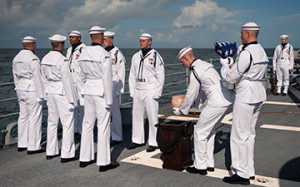
U.S. Navy personnel carry the cremated remains of Apollo 11 Commander Neil Armstrong during a burial at sea service aboard the USS Philippine Sea on Friday, Sept. 14. Credit: NASA/Bill Ingalls
Armstrong, who in his years before becoming a NASA astronaut served in the Navy from 1949 to 1952, was honored with a bugler and a rifle salute. Armstrong’s cremated remains were then committed to the sea and an American flag was presented to his widow, Carol as part of the ceremony.
On Friday, former Apollo astronauts, NASA Administrator Charles Bolden, and other dignitaries had come together at Washington’s National Cathedral to pay tribute to Armstrong. “Neil will always be remembered for taking humankind’s first small step on another world,” said Administrator Bolden. “But it was the courage, grace and humility he displayed throughout his life that lifted him above the stars.”
“Neil Armstrong left more than footprints and a flag on the moon,” Bolden added. “He left a foundation for the future and paved the way for future American explorers to be the first to step foot on Mars or another planet.”
Among those in attendance at Friday’s memorial service were Armstrong’s Apollo 11 crewmates Michael Collins and Buzz Aldrin. Also on hand was Eugene A. Cernan, the Apollo 17 mission commander and last man to walk on the moon, and John Glenn, the former Senator and first American to orbit the Earth.
“In Neil’s mind, it was never about Neil,” said Apollo 17 Commander Gene Cernan. “It was about you, your mothers and fathers, your grandparents, those of an earlier generation, who gave him the opportunity to walk on the moon. . . . He always gave credit to those who just didn’t know it couldn’t be done.”
“He knew who he was and he understood the immensity of what he had done. Yet Neil was always willing to give of himself,” said Cernan, who told of trips that he, Armstrong and Apollo 13 commander Jim Lovell made to visit troops in Afghanistan and Iraq.
“Those young men and women, who had yet to be born when Neil walked on the moon, greeted him with enthusiasm,” said Cernan. “They asked him, ‘Why are you here?’ Neil’s honest and thoughtful reply was, ‘Because you are here’.”
Armstrong’s words “That is one small step for (a) man, one giant leap for mankind,” spoken on July 20, 1969, as he became the first person ever to step onto another planetary body, instantly became a part of history.
Those few words from the Sea of Tranquillity were the climactic fulfillment of the efforts and hopes of millions of people and the expenditure of billions of dollars. A plaque on one of the lander’s legs that concluded “We came in peace for all mankind,” further emphasized that Armstrong and his fellow astronauts that followed were there as representatives of all humans.
The video of the ceremony as well as the memorial can be viewed online at NASA’s web site – nasa.gov.
![Herbal Reference Substances are Key to Everyday Products <!-- AddThis Sharing Buttons above -->
<div class="addthis_toolbox addthis_default_style " addthis:url='http://newstaar.com/herbal-reference-substances-are-key-to-everyday-products/3512112/' >
<a class="addthis_button_facebook_like" fb:like:layout="button_count"></a>
<a class="addthis_button_tweet"></a>
<a class="addthis_button_pinterest_pinit"></a>
<a class="addthis_counter addthis_pill_style"></a>
</div>When it comes to quality control testing and the development of new products, Botanical Reference Materials (BRMs), also known as Herbal References are critically important. To help companies ultimately obtain all-important FDA approval, the Food and Drug Administration provides in its guidance a recommendation that […]<!-- AddThis Sharing Buttons below -->
<div class="addthis_toolbox addthis_default_style addthis_32x32_style" addthis:url='http://newstaar.com/herbal-reference-substances-are-key-to-everyday-products/3512112/' >
<a class="addthis_button_preferred_1"></a>
<a class="addthis_button_preferred_2"></a>
<a class="addthis_button_preferred_3"></a>
<a class="addthis_button_preferred_4"></a>
<a class="addthis_button_compact"></a>
<a class="addthis_counter addthis_bubble_style"></a>
</div>](http://newstaar.com/wp-content/uploads/2021/02/Achillea_millefolium_flowers-100x100.jpg)
![Quality Electrochemical Biosensors are Critical for Medical, Food and Chemical Industry <!-- AddThis Sharing Buttons above -->
<div class="addthis_toolbox addthis_default_style " addthis:url='http://newstaar.com/quality-electrochemical-biosensors-are-critical-for-medical-food-and-chemical-industry/3512086/' >
<a class="addthis_button_facebook_like" fb:like:layout="button_count"></a>
<a class="addthis_button_tweet"></a>
<a class="addthis_button_pinterest_pinit"></a>
<a class="addthis_counter addthis_pill_style"></a>
</div>A number of industries have, at their core, a need to frequent or even continuous analysis of biological media. These include the medical and pharmaceutical fields, biotech firms, and food and chemical companies. To maintain quality standards and develop new products, these industries rely heavily […]<!-- AddThis Sharing Buttons below -->
<div class="addthis_toolbox addthis_default_style addthis_32x32_style" addthis:url='http://newstaar.com/quality-electrochemical-biosensors-are-critical-for-medical-food-and-chemical-industry/3512086/' >
<a class="addthis_button_preferred_1"></a>
<a class="addthis_button_preferred_2"></a>
<a class="addthis_button_preferred_3"></a>
<a class="addthis_button_preferred_4"></a>
<a class="addthis_button_compact"></a>
<a class="addthis_counter addthis_bubble_style"></a>
</div>](http://newstaar.com/wp-content/uploads/2020/10/Electrochemical-Biosensor-100x100.jpg)
![Company Develops Industrial Mixers Well-Suited for both Fragile and Explosive Products <!-- AddThis Sharing Buttons above -->
<div class="addthis_toolbox addthis_default_style " addthis:url='http://newstaar.com/company-develops-industrial-mixers-well-suited-for-both-fragile-and-explosive-products/3512071/' >
<a class="addthis_button_facebook_like" fb:like:layout="button_count"></a>
<a class="addthis_button_tweet"></a>
<a class="addthis_button_pinterest_pinit"></a>
<a class="addthis_counter addthis_pill_style"></a>
</div>Industrial drum mixers are normally applied to blend mixes of varying viscosities such as adhesive slurries or cement. Some of these mixers have the capability of blending mixes of very different particle sizes such as fruit and ice cream, and gravel and cement slurry. The […]<!-- AddThis Sharing Buttons below -->
<div class="addthis_toolbox addthis_default_style addthis_32x32_style" addthis:url='http://newstaar.com/company-develops-industrial-mixers-well-suited-for-both-fragile-and-explosive-products/3512071/' >
<a class="addthis_button_preferred_1"></a>
<a class="addthis_button_preferred_2"></a>
<a class="addthis_button_preferred_3"></a>
<a class="addthis_button_preferred_4"></a>
<a class="addthis_button_compact"></a>
<a class="addthis_counter addthis_bubble_style"></a>
</div>](http://newstaar.com/wp-content/uploads/2020/06/bandeau-sofragir2-100x100.jpg)